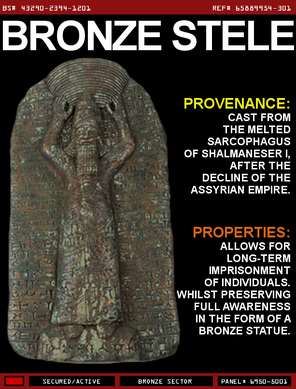This Mesopotamian Bronze Stele is an artifact first featured in "TBA".
History[]
The stele artifact was used presumably since 1250 B.C., but the original bronzing process was time consuming and heavy, and if not performed properly, the bronzed person will start to crumble away.
Paracelsus, Caretaker of Warehouse 9, improved or perfected the stele's bronzing process through unclear means.
By Warehouse 13, the stele was kept in a special containment box connected to a sophisticated device known as the Bronzer in the Bronze Section. The current process involves flash-freezing the prisoner via cryogenics, encasing them in ice before they are then bronzed.
Effects[]
This artifact is used (along with the right equipment) to preserve people in the form of a bronze statue.
An unspecified chemical compound can be made that, when ingested, permanently makes the consumer immune to the bronzing process entirely.
Real World Connections[]
A stele, also stela is a stone or wooden slab, generally taller than it is wide, erected for funerals or commemorative purposes, most usually decorated with the names and titles of the deceased or living.
Shalmaneser I (1274 BC – 1245 BC or 1265 BC – 1235 BC) was a king of Assyria during the Middle Assyrian Empire (1365 - 1050 BC). He conquered eight countries, brought the dust of the destroyed fortress of Arinnu to the capitol of the Old Assyrian Empire, claimed to have blinded 14,400 enemy prisoners in one eye, and was one of the first Assyrian kings known to deport defeated enemies to various lands rather than execute them all. It is possible that his choice of punishment, rather than using lethal force, could have been responsible for its imprisoning properties.
Trivia[]
- Although this artifact is attributed to have been constructed from the sarcophagus of Shalmaneser I, from the 13th century BC, this artifact is visually based on the Stele of Ashiburnipal,[1] an Assyrian king in the 7th century BC who was ironically known for his cruelty against those who took arms against the Assyrian monarchy (and never committed violent acts towards the civilian population).
- The Middle Assyrian Empire lasted from the 14th century BC to the 11th, and Shalmaneser I ruled between those dates. However, it was after Ashiburnipal's death in 627 BC that the Old Assyrian Empire began to experience internal civil wars that ultimately led to its downfall. It is possible, but unknown why, that the show's writers may have switched or gotten these two rulers confused.
- Alternatively, they may have simply chosen that stele simply because it was accessible, and/or because the figure's pose resembled that of those who are put into the Bronzer, as they are cuffed.
- The Middle Assyrian Empire lasted from the 14th century BC to the 11th, and Shalmaneser I ruled between those dates. However, it was after Ashiburnipal's death in 627 BC that the Old Assyrian Empire began to experience internal civil wars that ultimately led to its downfall. It is possible, but unknown why, that the show's writers may have switched or gotten these two rulers confused.
- The exact effects of the stele, and the bronzing process as a whole, are inconsistent throughout the series: In "MacPherson", it is explained that the bronzing process involves freezing the prisoner first, and that they are encased in bronze. Later, in "The Truth Hurts", Paracelsus consumes a chemical concoction that renders him immune to the bronzing process, but no mention is made to having to be frozen first, and it is unlikely a consumable compound could make one's body immune to freezing.
Appearances[]
References[]

Reproduction of display card as seen in the episode